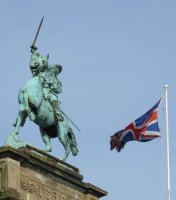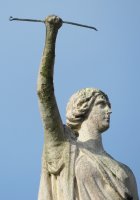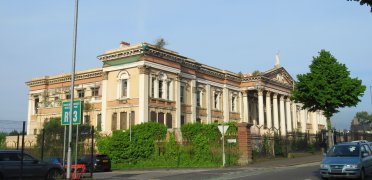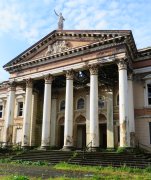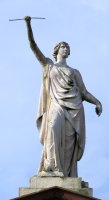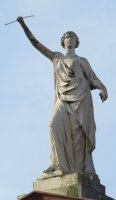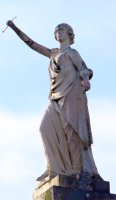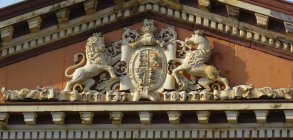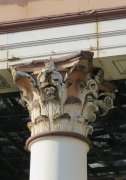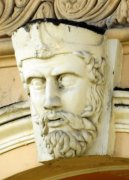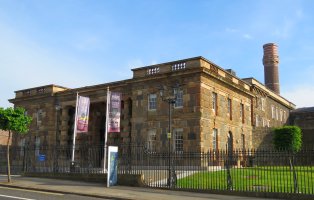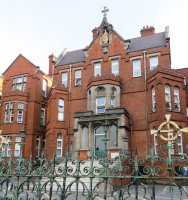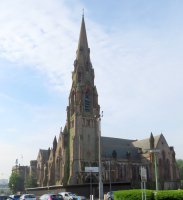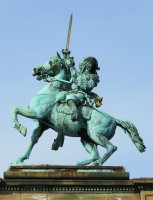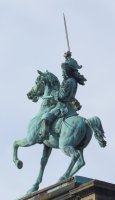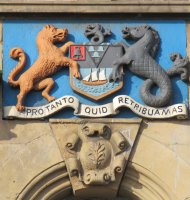Crumlin Road to Clifton Street, Belfast: statues and architecture
Crumlin Road contains two buildings by the pre-eminent Belfast architect Charles Lanyon, one with a statue by the sculptor William Kirk, and walking towards the city centre to Carlisle Circus and thence to Clifton Street showcases buildings by two other Belfast architects, and a fine equestrian statue of William III by sculptor Harry Hems.
Crumlin Road – County Court, Justice statue and the Gaol
County Court building, by Belfast architect Charles Lanyon.
In Crumlin Road, Belfast stands the County Court building (88-92 Crumlin Road), an important example of work by the architect Charles Lanyon, Belfast County Surveyor, who also designed the Palm House noted on this website, along with many other Belfast buildings. The statue on top of the portico is by the Irish sculptor Joseph Kirk.
First the statue. It is Justice of course, a massive standing stone figure, raising one hand high, grasping just the surviving crossbar of her lost scales; her other hand, held forwards, originally rested on her sword of justice. One foot thrusts forward - for Justice should be seen to advance - and from the left had side, we can see that her upper body is slightly angled backward, in a pose borrowed more from the 14th Century than the Classical. For she is very Classical, with a great cloak over a slighter, figure-hugging inner garment, leaving her arms and one breast bared (naked Truth as it were), and below, skirts down to her feet, the visible one, though ruined, is seemingly bare and sandalled in the correct style. The statue is rather beaten up, from its exposed position for 170 years, and the digits of the hands and foot are worn away, and the surface peeling off arms and face. Yet still we have an impressive statue, with a nice sway to the body as seen from the front, and harmonious folds of drapery across the stomach and legs.
Justice figure on top of County Court building.
The statue is said on the information board in front of the building to be by Joseph Robinson Kirk, but the fairly comprehensive and reliable source for Irish sculptors, Strickland’s Dictionary of Irish Artists, says it is by his brother, William Boyton Kirk. The piece does not seem to have been exhibited, though Joseph Kirk did show a statuette of Justice at the Royal Hibernian Academy exhibition. Both brothers mainly produced portrait sculpture, but both produced an oeuvre of ideal figures too, and I have not seen enough of their work to take a view. More on the Kirk family of sculptors on this page.
Below the statue, in the pediment, is a finely made Royal coat of arms, painted cast iron I think, but it is not recorded if this too was designed by Kirk.
Details of Lanyon's 1850 portico.
The building was put up in 1848-50, and the massive central portico, pediment and statue remain as conceived, as well as the railings. The ranges to left and right were originally set back a little, with forward projecting corners, and a 1905-1906 enlargement of the building by the architects Young and Mackenzie brought forward these side ranges and made the building a little wider, as well as extending significantly to the rear and remodelling much of the interior. While the general style of the frontage has been maintained, and looks most impressive still, the varied contour has been lost, and there is a simplification, including loss of some balconies and the Corinthian capitals to the sides. The building shut in 1989, and has suffered a series of fires since, and after various vicissitudes is now planned for renovation as a hotel.
Charles Lanyon's Crumlin Road Gaol.
Opposite the Court, and connected by an underground passage for the transport of those judged guilty, is the old HMP Belfast, or Crumlin Road Gaol, dating slightly earlier from 1848, now an entertainment complex. The building is again by Charles Lanyon, and serves to demonstrate his ability to vary his style, as well as give a sense of massiveness and solidity, most appropriate for both jailhouse and courthouse.
Ambling back towards the city centre along Crumlin Road, on the same side as the jail is a grand hospital [Mater Infirmorum Hospital], designed by the architect William J. Fennell, and dating from 1900. Red brick in Tudorish style, with lots of battlements, and in the central gable, a statue of a woman, perhaps Charity. A joltingly insensitive modern glass block follows, and then a further surviving block, dated 1932 and in Queen Anne style, with a further standing figure.
Carlisle Circus, Orange Hall and William III
Shortly afterwards, Crumlin Road ends at a roundabout, Carlisle Circus, faced by a grand Victorian church, the Carlisle Memorial Methodist Church, which forms the first of a nice trio of buildings along Clifton Street.
Methodist Church with Victorian Gothic tower.
The Church tower is outstanding - wilfully craggy Victorian Gothic, with many pinnacles and rising to a fine spire, all in stone with terra cotta dressings. The architect was W.H. Lynn, another prominent Belfast architect, who at one time was partner to Charles Lanyon, and the building was erected in 1873-75. James Carlisle, after whom the circus and the church are named, was a leading builder of the time, and in fact it was his firm that built the Crumlin Road Court noted above. The former church hall next to the church, in similar but calmer style, at no.86, includes a short octagonal tower. And next to this we have the Orange Hall, with a renaissance feel, three stories high and with a balustrade.
Orange Hall, by William Batt, with statue of William III.
The architect of Belfast's Orange Hall was William Batt of Belfast, who designed a number of Orange halls elsewhere, and also the fine former National Bank Office building in High Street, Belfast, along the road from the Albert Clock Tower, in a fanciful High Victorian style with minor decorative sculpture. At one time, there was a second major church on Carlisle Circus, St Enoch, for the Presbyterians, but this was destroyed by arson in 1985.Harry Hem's William III - different views.
On top of the Orange Hall is a bronze equestrian statue of William III [William of Orange]. The horse rears up, and the king sits looking towards the road, his sword raised up. The sculptor was Harry Hems, an Exeter sculptor best known for more minor decorative work and carved church furniture, which he produced en masse from his successful ecclesiastical artwork company in Exeter. Some of his church work is very ambitious – the vast restored screen in St Albans Cathedral is his for example – but free standing bronze sculpture is another thing, so the William III statue is something rather special and should be cherished.
Alas, the acclaimed statue of William III in Dublin by Grinling Gibbons, was repeatedly damaged, and pulled down in 1929, seen as a sectarian symbol rather than an outstanding work of sculpture. However, across the UK there are several other prominent equestrian statues of King William III, generally based on the Roman statue of Marcus Aurelius, by various sculptors. See the note on the page about the Petersfield, Hampshire statue. The Orange Hall version is not at all based on Marcus Aurelius, so is special in this aspect too. Splendid.
Above the door of the building is the carved coat of arms of Belfast, with a rampant wolf and a seahorse or hippogriff as supporters.
Proceeding further takes us immediately across the motorway to the city centre, with further splendid architecture continuing on Clifton Steet (18th Century Clifton House) and thence to atmospheric Donegal street, St Patrick’s Church and other interesting buildings and sculpture.

